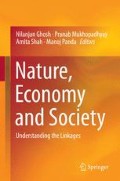Abstract
Prosopis juliflora, an exotic plant popularly known as the poor man’s fuel wood, has been spreading all over the country. In the semiarid region of Tamil Nadu, especially in and around Ramnad district, P. juliflora has been systematically harvested and the charcoal made out of this plant has many industrial uses. The present investigation found that charcoal making out of P. juliflora is as lucrative as rainfed rice cultivation in this region. Therefore, most of the local inhabitants prefer to go for charcoal making rather than rainfed agriculture. Though local people economically benefited from this exotic plant, they also face severe ecological problems such as loss of grazing land, reduction of medicinal plants’ diversity, reduced availability of meat and milk, change in land-use pattern and loss of ecosystem services. Our findings suggest that effective management of P. juliflora stands should be given the highest priority to maintain the quality of ecosystem services in this region.
Access this chapter
Tax calculation will be finalised at checkout
Purchases are for personal use only
References
Ansley RJ, Huddle JA, Kramp BA (1997) Mesquite ecology. In: Rollins D, Ueckert DN, Brown CG (eds) Proceedings of brush sculptors symposium, Texas, 1997
Chandrasekaran S, Swamy PS (2002) Biomass, litterfall and aboveground net primary productivity of herbaceous communities in varied ecosystems at Kodayar in the western ghats of Tamil Nadu. Agric Ecosyst Environ 88:61–71
Chandrasekaran S, Swamy PS (2010) Growth patterns of Chromolaena odorata in varied ecosystems at Kodayar in the Western Ghats, India. Acta Oecologica 36:383–392
Dodia PP (2011) Roost tree selection by the common Indian Peafowl (Pavo cristatus) at Bhavnagar district, Gujarat (India). Life Sci Leafl 11:346–354
Krishnankutty N, Chandrasekaran S, Jeyakumar G (2006) Evaluation of disturbance in a tropical dry deciduous forest of Alagar hill (Eastern Ghats), South India. Trop Ecol 47:47–55
Laxen J (2007) Is Prosopis a curse or a blessing? An—ecological-economical analysis of an invasive alien tree species in Sudan. In: Luukkanen O (ed) Tropical forestry reports VITRI. University of Helsinki, Finland, p 199
Litvaitis JA, Sherburne JS, Bissonette JA (1985) Influence of understory characteristics on snowshoe hare habitat use and density. J Wildl Manage 49:866–873
Ojeda M, Keith LB (1982) Sex and age composition and breeding biology of cottontail rabbit populations in Venezuela. Biotropica 14:99–107
Ramakrishnan PS (1991) Ecology of biological invasion in the tropics. International Scientific Publications, New Delhi
Rilov G, Crooks JA (2009) Biological invasions in marine ecosystems: ecological, management, and geographic perspectives. Springer-Verlag, Berlin
Singh SP (1989) Biological suppression of weeds. Biological Control Centre, Bangalore
Singh KP, Shukla AN, Singh JS (2010) State-level inventory of invasive alien plants, their source regions and use potential. Curr Sci 99:107–114
Thomas PA, Room PM (1986) Taxonomy and control of Salvinia molesta. Nature 320:581–584
Vimal OP, Tyagi PD (1986) Prosopis juliflora chemistry & utilization. In: Patel VJ (ed) Role of Prosopis in wasteland development. Jivrajbhai Patel Agroforestry Centre, Gujarat
Whittaker RH (1970) The biochemical ecology of higher plants. In: Sondheimer E, Simeone, B (eds) Chemical ecology. Academic Press, New York, pp 43–70
Williamson M (1996) Biological invasions. Chapman and Hall, London
Wolff JO (1980) The role of habitat patchiness in the population dynamics of snowshoe hare. Ecol Monogr 50:111–130
Acknowledgments
We thank UGC-CAS, DST-PURSE and DBT-IPLS, Government of India, New Delhi for providing financial assistance through various research schemes.
Author information
Authors and Affiliations
Corresponding author
Editor information
Editors and Affiliations
Rights and permissions
Copyright information
© 2016 Indian Society for Ecological Economics
About this chapter
Cite this chapter
Chandrasekaran, S., Swamy, P. (2016). Ecological and Socioeconomic Impacts of Prosopis juliflora Invasion in the Semiarid Ecosystems in Selected Villages of Ramnad District in Tamil Nadu. In: Ghosh, N., Mukhopadhyay, P., Shah, A., Panda, M. (eds) Nature, Economy and Society. Springer, New Delhi. https://doi.org/10.1007/978-81-322-2404-4_18
Download citation
DOI: https://doi.org/10.1007/978-81-322-2404-4_18
Published:
Publisher Name: Springer, New Delhi
Print ISBN: 978-81-322-2403-7
Online ISBN: 978-81-322-2404-4
eBook Packages: Economics and FinanceEconomics and Finance (R0)

